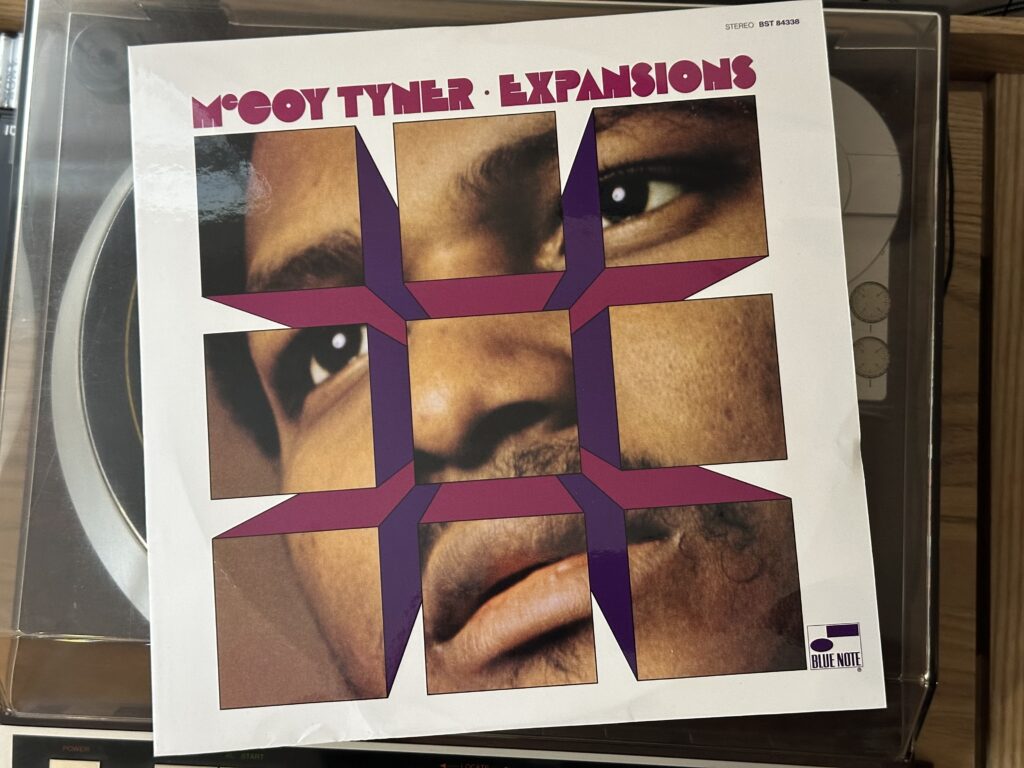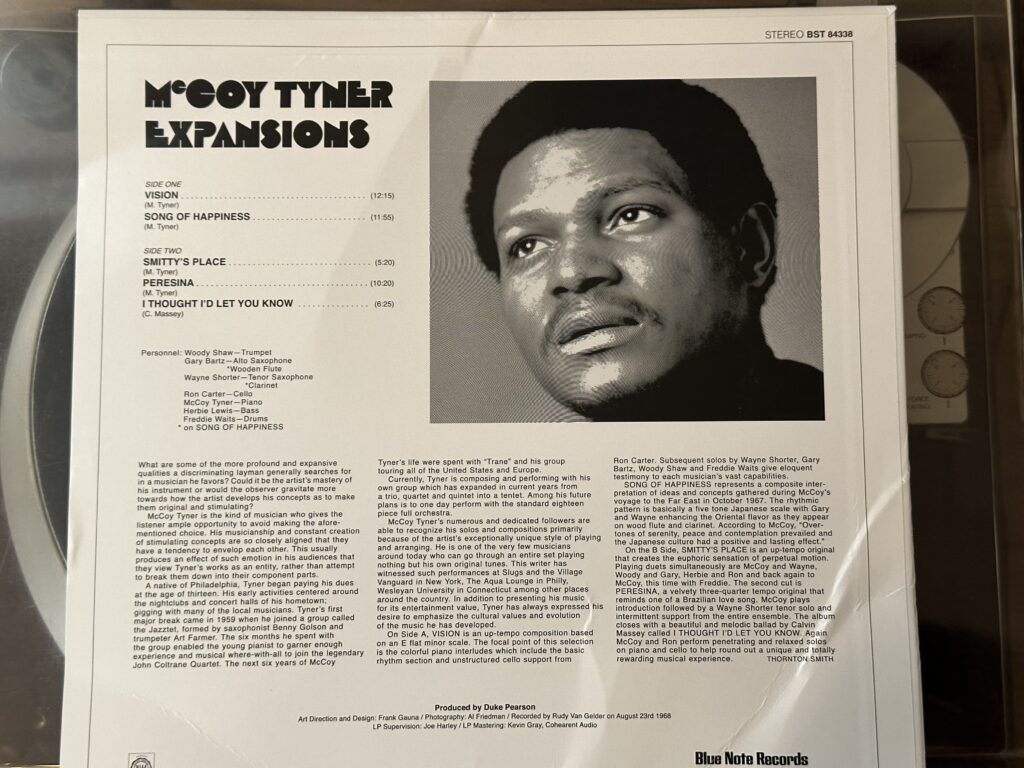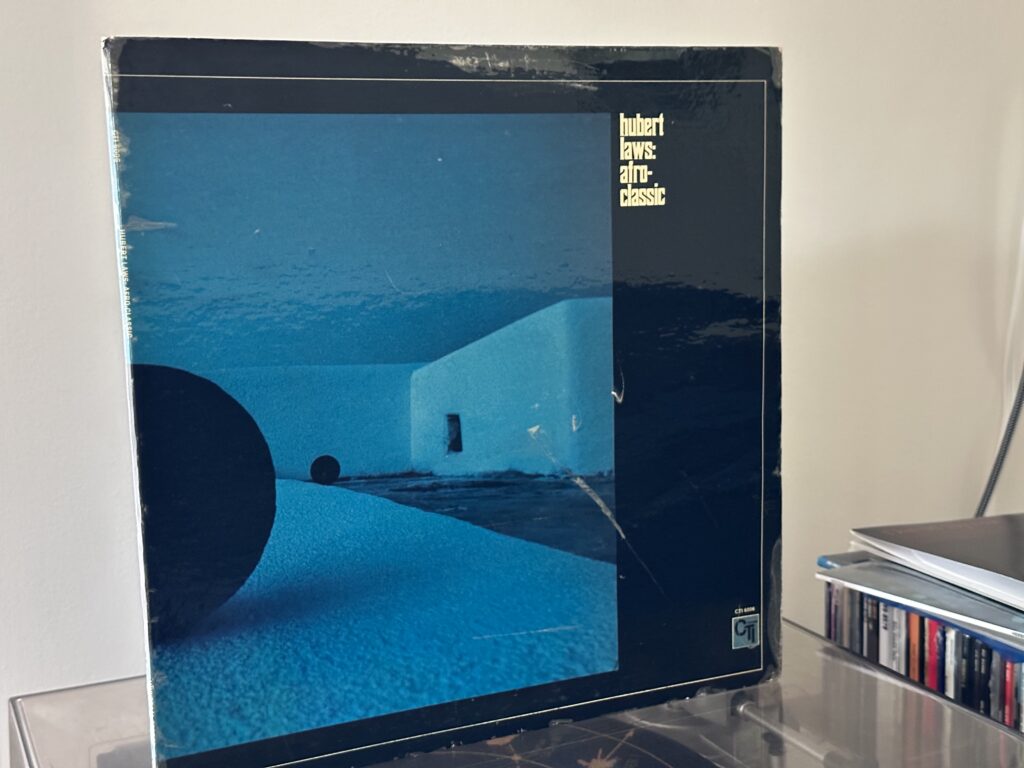
Album of the Week, April 13, 2024
The classic John Coltrane Quartet was no more after December 1965, as first McCoy Tyner then Elvin Jones despaired of being able to follow Trane to the places he was going. Trane died, unexpectedly and awfully, of liver cancer at the age of 40, on July 17, 1967. But Trane’s musical legacy lived on, most notably through those who played with him and the unmistakably audible legacy his works left in theirs. Tyner was one of those, and as we’ll hear over the next few weeks, Trane’s influence ran strong in Tyner’s works for years afterwards.
Following Tyner’s departure from the Quartet, he signed with Blue Note Records and recorded a series of albums that gradually expanded Tyner’s compositional and performing concept beyond the boundaries of the jazz quartet. On Expansions, the fourth in the series (following The Real McCoy, Tender Moments, and Time for Tyner), we get an intriguing mix of modal jazz, the avant-garde, and more traditional sounds, delivered by a septet of players that included Woody Shaw on trumpet, Gary Bartz on alto sax (and wooden flute), Wayne Shorter on tenor sax (and clarinet), Herbie Lewis on bass, Freddie Watts on drums, and Ron Carter, who plays cello here.
Shaw would go on to record on sessions with Joe Zawinul (he actually appears on Zawinul), as well as . Gary Bartz had previously performed with Tyner in Charles Mingus’s workshop and would record with him again before working with Miles Davis in 1970 (resulting in the Live-Evil album) and beginning his own influential band, the NTU Troop. Herbie Lewis recorded with a long list of influential 1960s players including Cannonball Adderley, Stanley Turrentine, Bobby Hutcherson, Freddie Hubbard, Jackie McLean, Archie Shepp, Harold Land, and others. And Freddie Watts worked with Max Roach, Kenny Barron, Andrew Hill, Joe Zawinul, Freddie Hubbard, and others.

When you hear “Vision,” you could be forgiven for thinking you were hearing a leftover melody from a Coltrane session, at least until the horns enter. Tyner’s harmonic imagination is strongly influenced by Trane’s modal material. But the horns, who play the opening statement of the melody add a new element that’s distinct from the Coltrane style. And Ron Carter’s cello solo, which provides both melody and texture by playing with light pressure on the fingerboard while bowing (sul ponticello), takes the tune even further into unknown reaches. Wayne Shorter, Gary Bartz, and Woody Shaw each take a solo. Shorter’s harmonic imagination is interesting here as he plays unusually aggressively compared to his performances as a group leader. There are touches of some of his playing on Miles Smiles in the speed and bite of his playing. Bartz plays more melodically by contrast, but brings in some distortion in the saxophone. And Shaw goes even further out, playing into the upper reaches and moving well beyond the chords of the tune. The overall tune pushes beyond traditional jazz forms, urged on by Tyner’s percussive playing and Freddie Watts’ drums.
“Song of Happiness” comes from a more meditative center. The opening is played over a static chord with the piano and bass constantly in motion without moving far from the central tonality. A melody starts in the bass and is accompanied by the constantly rolling piano and, ultimately, by wooden flute and clarinet, played by Bartz and Shorter. Finally, the horns come in on a secondary melody and are answered by the bass and piano, tossing the development of the melody back and forth in eight bar patterns. Solos follow from Tyner and Shorter, and the group returns to the flute for the long coda. There’s more than a hint of the East in the arrangement, and it shows how Tyner’s imagination was broadening beyond the minor key workouts of the classic quartet.
“Smitty’s Place,” by contrast, feels almost like an Archie Shepp workout, with a clear melody alternating with free playing from the band. Shorter’s solo here is much closer to his normal playing of the late 1960s, with shadows of his Schizophrenia. The pizzicato cello solo by Carter is one of the farthest-out things on the whole record, and Tyner’s closing solo definitely the funniest.
“Peresina” finds us back in a familiar minor modal groove, led by Tyner’s assertive solo and followed by the melody which is stated in the horns. But at about the two minute mark the tune takes a left turn into something more complex chordally, and suddenly the feel is less percussive, more dancelike. It’s an interesting tune, well played by the band; again, Shorter’s solo stands out for its left turns into unusual tonalities and moments.
Last, “I Thought I’d Let You Know” is the only non-Tyner composition on the album. Written by Cal Massey, who played with Tyner and Jimmy Garrison in Philadelphia in the 1950s, the work opens with a cello feature by Carter before turning to a tender piano solo from Tyner. The two alternate with support from the rhythm section throughout. The overall effect has the serenity of “Song of Happiness” in a more traditional format, as if to say: this, too, remains.
On Expansions, McCoy Tyner’s compositional skills and range are on full display. While still touched by the shadow of Trane’s influence, tracks like “Song of Happiness” and “Smitty’s Place” show that Tyner could stretch convincingly into his own definition of the avant-garde and could command a substantially broader tonal palette. We’ll hear more of that in coming recordings from him; next week, though, we’ll check out another post-Trane recording from one of his later collaborators.
You can listen to this week’s album here:

